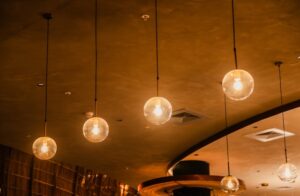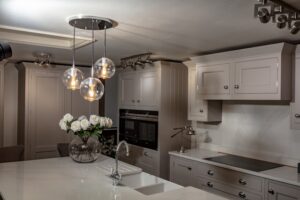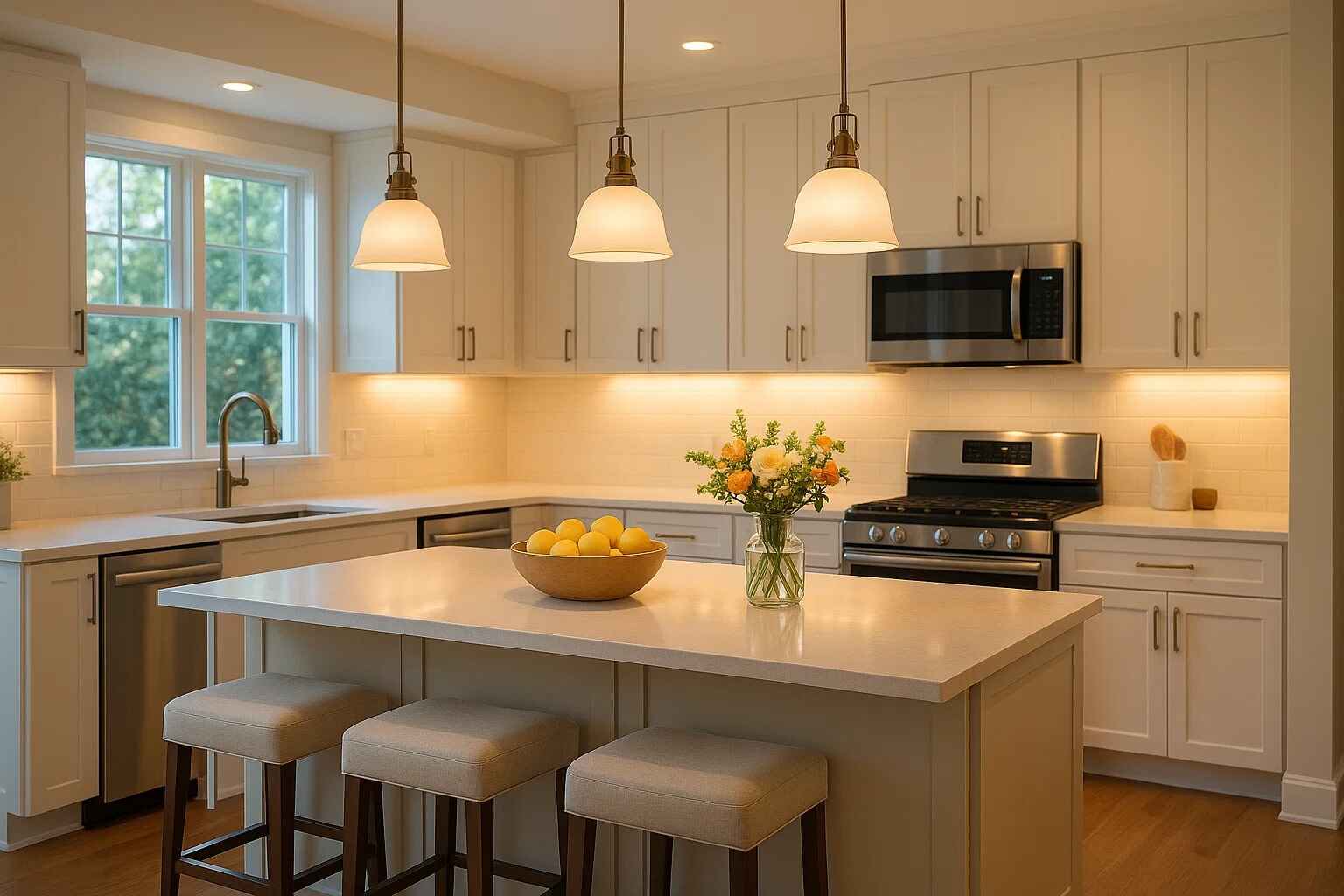Introduction
The right kitchen lights do more than just illuminate your space; they set the mood, improve functionality, and enhance your home’s design. With countless options available, finding the perfect fixtures can feel overwhelming. This guide simplifies the process, exploring different lighting layers, popular styles, and practical considerations to help you create a beautifully lit kitchen. We will cover everything from task lighting over your countertops to ambient fixtures that create a warm, inviting atmosphere for your family and guests. Let’s brighten up your culinary world.
Understanding the Layers of Kitchen Lights
Effective kitchen lighting combines three distinct layers to create a balanced and functional environment. Each layer serves a specific purpose, and together they ensure your kitchen is both practical and welcoming. Thoughtful planning is key to achieving this harmony.
Ambient Lighting
Ambient lighting is the foundation of your kitchen’s illumination. It provides overall, general light, filling the room and allowing you to move around safely. This is typically achieved with ceiling-mounted fixtures like recessed lights, flush mounts, or chandeliers.
Task Lighting
Task lighting focuses on specific work areas, ensuring you have clear visibility for chopping, cooking, and reading recipes. Under-cabinet lights are a prime example, casting direct light onto your countertops without creating shadows. Pendants over an island also serve this purpose well.
Accent Lighting
Accent lighting adds a decorative touch, highlighting architectural features or decor. Think of it as the jewelry of your kitchen. This could include in-cabinet lights to display glassware or a spotlight on a piece of art, adding depth and visual interest.
Popular Types of Kitchen Lights
Choosing the right fixture style is crucial for both function and aesthetics. From modern to traditional, there are kitchen lights to match any decor. Combining different types often yields the best results, creating a dynamic and layered lighting scheme.
Popular options include:
- Recessed Lighting: Sleek and modern, these are installed directly into the ceiling, providing widespread ambient light.
- Pendant Lights: Hung from the ceiling, they are perfect for task lighting over islands or dining areas.
- Under-Cabinet Lighting: Essential for task illumination, these fixtures brighten countertops directly.
- Chandeliers: A bold statement piece that adds elegance and ambient light, often placed over a dining table.
- Track Lighting: A versatile option where multiple lights are mounted on a single track, allowing you to direct light where it’s needed most.
Choosing Lights for Your Kitchen Island
Your kitchen island is a multifunctional hub, and its lighting should reflect that. A popular choice is a series of pendant lights. For proper spacing, a general rule is to hang them about 30-36 inches above the countertop and leave 24-30 inches between each fixture.
Consider the scale of your island when selecting pendants. A large island can handle bigger, more dramatic fixtures, while a smaller one benefits from more modest designs. A linear suspension light can also be a great alternative, providing even illumination across the entire surface.

The Importance of Under-Cabinet Kitchen Lights
Under-cabinet lighting is a game-changer for kitchen functionality. It eliminates shadows cast by overhead lights and your own body, making tasks like chopping vegetables much safer and easier. This focused illumination is a key component of effective task lighting.
LED strips or puck lights are the most common choices for this application. They are energy-efficient, long-lasting, and offer a low-profile design that stays hidden from view. Many options are dimmable, allowing you to adjust the brightness for tasks or for a softer, ambient glow.
Smart Kitchen Lights for Modern Homes
Smart lighting technology brings convenience and customization to your kitchen. With smart kitchen lights, you can control brightness, color temperature, and even set schedules directly from your smartphone or with voice commands through assistants like Alexa or Google Home.
Imagine dimming the lights for a dinner party or brightening them for meal prep with a simple command. Smart systems can also help you save energy by ensuring lights are off when the room is empty. It’s a modern upgrade that adds significant value and functionality.
How to Select the Right Bulb Brightness
Understanding lumens, the measure of brightness, is essential when choosing bulbs for your kitchen lights. For general ambient lighting, aim for a total of 3,000 to 6,000 lumens. For focused task areas like countertops and islands, you’ll want a stronger 450 lumens per square foot.
Color temperature, measured in Kelvins (K), also plays a vital role. A warm white (2700K-3000K) creates a cozy, inviting atmosphere for dining areas. For task zones, a cooler, neutral white (3500K-4500K) mimics daylight and improves visibility for cooking.
Energy-Efficient Kitchen Lighting Solutions
Switching to energy-efficient kitchen lights can significantly reduce your electricity bill and environmental impact. LED bulbs are the leading choice, as they use up to 80% less energy than traditional incandescent bulbs and can last for many years.
When shopping, look for the ENERGY STAR label, which certifies that the product meets strict energy-efficiency guidelines. Dimmers are another great tool for saving energy, as they allow you to use only the amount of light you need at any given moment.
Matching Kitchen Lights to Your Decor Style
Your kitchen lights should complement your overall design aesthetic. For a modern kitchen, consider sleek track lighting or minimalist pendants with clean lines. A farmhouse-style kitchen pairs well with rustic fixtures made from wrought iron or distressed wood.
Traditional spaces benefit from classic chandeliers or lantern-style pendants. Don’t be afraid to mix and match, but ensure there is a common element—like finish or color—that ties all the fixtures together for a cohesive look.
Professional Installation vs. DIY
While some lighting projects are DIY-friendly, others require a professional. Simple tasks like swapping a pendant or installing battery-operated under-cabinet lights can often be handled on your own. Always remember to turn off the power at the circuit breaker first.
However, for more complex work like installing new recessed lighting or running new wiring, it’s safest to hire a licensed electrician. They have the expertise to ensure everything is installed correctly and up to code, preventing potential fire hazards and other safety risks.
FAQs
H3: How many recessed lights do I need in a kitchen?
A good rule of thumb is to place one recessed light for every 4 to 6 square feet of ceiling space. Space them evenly to avoid dark spots. For an average-sized kitchen, this often means between 6 and 10 lights for sufficient ambient illumination.
H3: What is the best color temperature for kitchen lights?
For task areas like countertops, a neutral or cool white (3500K-4500K) is ideal because it enhances clarity. For general ambient and dining areas, a warm white (2700K-3000K) creates a more relaxed and inviting atmosphere. Many people use a combination for a layered effect.
H3: Can I put a dimmer on all my kitchen lights?
Most modern kitchen lights, especially LEDs, are compatible with dimmers, but you must check the product specifications. Using dimmers is highly recommended as it allows you to adjust the mood, from bright and functional for cooking to soft and intimate for dining.
H3: How do I clean my kitchen light fixtures?
First, turn off the power. For most fixtures, a gentle wipe with a dry microfiber cloth is enough to remove dust. For greasy buildup, use a cloth lightly dampened with water and a drop of mild dish soap, then wipe dry. Avoid harsh chemical cleaners.
H3: Should all my kitchen light fixtures match?
They don’t have to match perfectly, but they should be coordinated. Aim for a cohesive look by choosing fixtures that share a common element, such as the finish (e.g., brushed nickel, matte black), shape, or overall style (e.g., modern, industrial).
H3: What’s the difference between lumens and watts?
Lumens measure the brightness of a light bulb, while watts measure the amount of energy it consumes. With energy-efficient LEDs, it’s more important to shop by lumens to ensure you get the brightness you need, as a low-wattage LED can be very bright.
Conclusion
Selecting the right kitchen lights is a transformative step in designing a kitchen that is both beautiful and highly functional. By layering ambient, task, and accent lighting, you create a versatile space ready for any activity, from cooking elaborate meals to enjoying a quiet cup of coffee. Consider styles that complement your decor, embrace energy-efficient options like LEDs, and don’t overlook the power of smart technology and dimmers to customize your environment. A well-lit kitchen not only enhances safety and efficiency but also becomes the true heart of your home, radiating warmth and welcome.
Unlock Your Dream Layout with Lowes Kitchen Designer: Discover the Secret to Flawless Renovations

